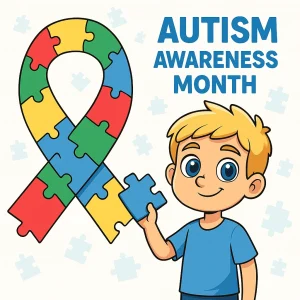Autism Meltdowns vs Tantrums: What Parents Need to Know
By Rajini D
Last Updated: April 11, 2025
Is it a tantrum or a meltdown? For parents of children with autism, telling the difference can be confusing — but it’s one of the most important things you can learn.
Understanding the behaviors of children on the autism spectrum can feel like navigating a complex maze. Each child processes the world uniquely, with differences in how they communicate, react, and cope with everyday challenges. Among these behaviors, two of the most misunderstood — autism meltdowns and tantrums — often look similar but come from completely different causes.
In this article, we’ll break down what makes autism meltdowns different from tantrums, explain their triggers, and give you practical strategies to handle both with confidence and compassion.
Don’t second-guess. Try our free autism test to understand if your child’s meltdowns or tantrums could signal something deeper.
Understanding Autism Meltdowns
What is an Autism Meltdown?
An autism meltdown is an intense response that occurs when someone on the autism spectrum experiences an overwhelming amount of stress, sensory stimuli, or emotional distress. Unlike a tantrum, a meltdown is not goal-oriented; it does not occur because the person wants something. Instead, it happens because they are trying to cope with an overload that is too much for their sensory system to handle.
Characteristics of an autism meltdown can include:
- Extreme distress: Crying, yelling, or physical aggression.
- Physical behaviors: Such as rocking, head-banging, or running away.
- Inability to communicate effectively: Struggling to express needs or feelings.
Meltdowns are not a manipulation tactic; they are a sign of genuine distress and a request for help or space.
Causes of Autism Meltdowns
Autism meltdowns are typically triggered by specific stressors or environmental factors that exceed the individual’s threshold for sensory input or emotional regulation. Common causes include:
- Sensory overload: Loud noises, bright lights, or crowded spaces can overwhelm the sensory system.
- Communication difficulties: Struggling to express needs or understand others can lead to frustration.
- Unexpected changes: Deviations from routine or sudden transitions may be difficult to process.
- Emotional stress: High levels of stress or emotional situations that are difficult to manage.
Understanding these triggers is crucial for parents and caregivers to help manage or prevent potential meltdowns.
Impact of Autism Meltdowns
The impact of autism meltdowns extends beyond the individual experiencing them. They can affect family dynamics, social situations, and educational or therapeutic settings. Effects include:
- Emotional distress for the individual: Feelings of helplessness, embarrassment, or exhaustion after a meltdown.
- Stress on family members and caregivers: Challenges in managing public situations or disruption of daily routines.
- Social consequences: Misunderstanding by peers or others who may not recognize the behavior as part of a disability.
- Educational disruptions: Difficulty maintaining a structured learning environment during or after a meltdown.
Recognizing Autism Tantrums
What is an Autism Tantrum?
An autism tantrum is a behavior commonly observed in children with autism spectrum disorder (ASD) and can sometimes be mistaken for typical childhood tantrums. However, autism tantrums often stem from deeper sensory sensitivities or communication barriers rather than the typical desires or frustrations seen in neurotypical children.
While neurotypical tantrums usually occur when a child wants attention or an object and stops once the child gets what they want, autism tantrums can persist because they are driven by the child’s inability to cope with their environment or express their needs effectively. Characteristics of autism tantrums may include:
- Intense outbursts of emotion such as crying or screaming.
- Physical behaviors like stomping or throwing objects.
- Prolongation of the tantrum despite attempts to appease the child.
Understanding these distinctions helps caregivers tailor their responses to the unique needs of a child with autism, rather than applying typical parenting strategies that may not be effective.
Common Triggers for Autism Tantrums
Autism tantrums are often triggered by factors that may not obviously distress neurotypical children. Recognizing these triggers is crucial for effectively managing and preventing tantrums. Common triggers include:
- Sensory overload: Overwhelming environments with too much noise, light, or crowd.
- Communication struggles: Frustration from not being able to express needs or understand others.
- Routine disruptions: Changes in the expected schedule or environment.
- Physical discomfort: Hunger, tiredness, or physical ailments.
By identifying what precipitates these tantrums, parents and caregivers can better prepare and possibly prevent these challenging episodes.
Managing Tantrums in Children with Autism
Effectively managing autism tantrums involves a combination of proactive strategies and interventions tailored to the individual needs of the child. Here are some effective strategies:
- Create a calm environment: Reduce sensory stimuli that can lead to tantrums. This might include having a quiet space where the child can go to feel safe and calm.
- Use visual aids: Help the child understand what to expect through visual schedules or choice boards.
- Develop communication skills: Use tools like speech therapy or picture exchange communication systems (PECS) to aid in expression.
- Consistent routines: Keep daily activities predictable and structured to reduce anxiety.
- Positive reinforcement: Reward desired behaviors to encourage their recurrence.
Key Differences Between Meltdowns and Tantrums
Behavioral Distinctions
Understanding the behavioral distinctions between autism meltdowns and tantrums is crucial for providing the right support to children with autism. Here’s a breakdown of the primary differences:
- Reactions: Meltdowns are intense responses to sensory overload or overwhelming emotions and are not goal-oriented. In contrast, tantrums are typically goal-driven, arising when a child wants something they are not receiving.
- Duration: Meltdowns can last from a few minutes to several hours and do not resolve quickly, even when the immediate stressor is removed. Tantrums tend to be shorter and often cease once the child’s desires are met or they realize that their behavior will not yield the desired result.
- Triggers: Meltdowns are usually triggered by sensory or emotional overload, such as loud noises or unexpected changes. Tantrums often occur in response to unmet needs or desires, such as wanting a toy or refusing to follow instructions.
Distinguishing between these behaviors helps in adopting the appropriate strategies to handle each situation, which can significantly ease the stress for both the child and the caregiver.
Handling Responses
Responding appropriately to meltdowns and tantrums is vital for effective parenting and caregiving. Here are tailored strategies for each:
- Responding to Meltdowns:
- Stay calm: Keeping your cool can help soothe the child.
- Reduce stimuli: Minimize noise, lights, and crowd interaction to lessen sensory overload.
- Provide space: Give the child a safe space where they can recover without feeling pressured or threatened.
- Use calming techniques: Gentle reassurances, deep breathing exercises, or quiet activities can help the child regain control.
- Responding to Tantrums:
- Set clear boundaries: Consistently enforce rules and boundaries in a calm and firm manner.
- Ignore goal-oriented behaviors: When safe, ignoring the tantrum can teach the child that these behaviors are not effective for getting what they want.
- Encourage communication: Help the child use words or other communication forms to express what they want or how they feel.
- Offer choices: Giving limited choices can help the child feel a sense of control while still doing what needs to be done.
Practical Strategies for Parents
Preventing Autism Meltdowns and Tantrums
Proactive measures and adjustments to the environment can significantly reduce the frequency and intensity of autism meltdowns and tantrums. Here are strategies that parents can implement:
- Create a Sensory-Friendly Environment: Customize living spaces to minimize sensory triggers. This could involve using soft lighting, reducing background noise, or creating a dedicated quiet space where your child can retreat to when feeling overwhelmed.
- Establish Routines: Predictable schedules provide structure that can be very comforting to children with autism. Try to keep daily activities consistent and predictable, and prepare your child in advance for any changes that might occur.
- Visual Schedules and Timers: Use tools like visual schedules, timers, and apps to help your child understand what to expect throughout the day. This can reduce anxiety and help them manage transitions between activities more smoothly.
- Educate Yourself on Triggers: Pay attention to the specific conditions or activities that lead to meltdowns and tantrums. Once identified, either modify these situations or teach your child strategies to cope with them.
Implementing these strategies not only helps in preventing challenging behaviors but also promotes a sense of security and confidence in your child.
During the Event: Tips and Techniques
When a meltdown or tantrum does occur, effective management techniques are crucial for calming your child. Here’s how you can manage these intense moments:
- Stay Calm: Your calm demeanor can help soothe your child. Children can often pick up on the caregiver’s stress, which can escalate the situation.
- Use Calming Techniques: Depending on your child’s preferences, use techniques such as deep breathing, gentle reassuring touches, or quiet songs to help soothe them. Each child is different, so it’s important to find out what works best for them.
- Provide a Safe Space: If possible, guide your child to a predetermined safe space where they can feel secure to express their emotions without risk of injury.
- Minimize Communication: During a high-stress moment, keep your language simple and your voice soft. Too many questions or commands can increase stress.
Post-Event Strategies
After a meltdown or tantrum, it’s important to help your child recover and to learn from the episode to better manage future incidents:
- Provide Comfort and Reassurance: After a meltdown, children often feel vulnerable. Offer a hug, some soothing words, or a favorite comfort object.
- Discuss the Event Calmly: Once everything has settled, discuss the event with your child in a calm and non-judgmental manner. This can help them understand and learn from what happened.
- Adjust Strategies: Reflect on what triggered the meltdown and what helped (or didn’t help) during the event. Use this information to refine your strategies, both for prevention and for managing future incidents.
- Plan and Prepare: Equip yourself and your child with tools and strategies for handling similar situations in the future. This might involve more specific environmental adjustments or introducing new coping strategies.
Conclusion
Understanding the difference between autism meltdowns and tantrums is key to effective support. Meltdowns stem from sensory overload, while tantrums are often about unmet wants. Effective strategies like maintaining routines and using calming techniques during episodes can make a big difference. Reflection after events helps improve future responses. Keep learning and adapting; resources like Wellness Hub offer tools and insights that empower you and your child. Visit Wellness Hub for more support, helping you navigate autism with confidence and positivity. Stay informed, stay supported!
Frequently Asked Questions:
1. What’s the difference between an autism meltdown and a tantrum?
An autism meltdown is an intense reaction to overwhelming situations and isn’t goal-oriented, while a tantrum is typically a child’s way to express frustration or to achieve a specific outcome.
2. How can I tell if my child is having an autism meltdown?
Look for signs like extreme distress, inability to communicate, or excessive physical movements, which may indicate sensory overload rather than a simple tantrum.
3. What are the main causes of autism meltdowns?
Common triggers include sensory overload, unexpected changes, and communication difficulties. Identifying these can help manage and prevent meltdowns.
4. How long do autism meltdowns last?
The duration can vary widely from a few minutes to several hours, depending on the situation and the individual’s stress levels.
5. Can autism meltdowns be prevented?
While not all meltdowns can be prevented, creating a supportive environment with routines and minimizing sensory overload can reduce their frequency.
6. What should I do during my child’s autism meltdown?
Stay calm, minimize environmental stimuli, provide a safe space, and use soothing techniques suited to your child’s preferences.
7. What are effective ways to manage tantrums in children with autism?
Use clear communication, maintain consistent routines, provide choices, and employ positive reinforcement to encourage desired behaviors.
8. When should I seek professional help for my child’s meltdowns or tantrums?
Consider professional advice if meltdowns or tantrums increase in intensity, pose safety concerns, or significantly disrupt daily life.
9. What type of professional support is available for managing autism-related behaviors?
Behavioral therapists, occupational therapists, speech-language pathologists, and special educators can provide strategies and interventions.
10. How can Wellness Hub help with managing autism meltdowns and tantrums?
Wellness Hub offers resources like sensory tools, educational materials, and access to expert advice that can help you understand and manage autism-related behaviors effectively. Visit Wellness Hub for more information.
About the Author:
Shravanaveena Gajula
M.Sc ., Speech and Language Pathology (5+ years of experience)
Shravanaveena Gajula is a dedicated Audiologist and Speech-Language Pathologist with a BASLP and an M.Sc in Speech and Language Pathology. With experience spanning multiple settings, including Wellness Hub and Ashray Akruti, Veena specializes in a wide range of disorders from developmental issues in children to speech and language assessments in adults. Her expertise includes parent counseling, managing speech sound and fluency disorders, and creating individualized therapy programs. Veena is also PROMPT certified and an author of several insightful blogs on speech and language pathology, aiming to educate and assist caregivers in supporting their loved ones.
Book your Free Consultation Today
Parent/Caregiver Info:
Client’s Details:
* Error Message








